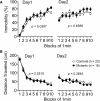Adenomatous polyposis coli heterozygous knockout mice display hypoactivity and age-dependent working memory deficits
- PMID: 22347851
- PMCID: PMC3276361
- DOI: 10.3389/fnbeh.2011.00085
Adenomatous polyposis coli heterozygous knockout mice display hypoactivity and age-dependent working memory deficits
Abstract
A tumor suppressor gene, Adenomatous polyposis coli (Apc), is expressed in the nervous system from embryonic to adulthood stages, and transmits the Wnt signaling pathway in which schizophrenia susceptibility genes, including T-cell factor 4 (TCF4) and calcineurin (CN), are involved. However, the functions of Apc in the nervous system are largely unknown. In this study, as the first evaluation of Apc function in the nervous system, we have investigated the behavioral significance of the Apc gene, applying a battery of behavioral tests to Apc heterozygous knockout (Apc(+/-)) mice. Apc(+/-) mice showed no significant impairment in neurological reflexes or sensory and motor abilities. In various tests, including light/dark transition, open-field, social interaction, eight-arm radial maze, and fear conditioning tests, Apc(+/-) mice exhibited hypoactivity. In the eight-arm radial maze, Apc(+/-) mice 6-7 weeks of age displayed almost normal performance, whereas those 11-12 weeks of age showed a severe performance deficit in working memory, suggesting that Apc is involved in working memory performance in an age-dependent manner. The possibility that anemia, which Apc(+/-) mice develop by 17 weeks of age, impairs working memory performance, however, cannot be excluded. Our results suggest that Apc plays a role in the regulation of locomotor activity and presumably working memory performance.
Keywords: Apc; behavioral test battery; hypoactivity; locomotor activity; working memory performance.
Figures







Similar articles
-
Targeted deletion of the C-terminus of the mouse adenomatous polyposis coli tumor suppressor results in neurologic phenotypes related to schizophrenia.Mol Brain. 2014 Mar 29;7:21. doi: 10.1186/1756-6606-7-21. Mol Brain. 2014. PMID: 24678719 Free PMC article.
-
Comprehensive behavioral phenotyping of a new Semaphorin 3 F mutant mouse.Mol Brain. 2016 Feb 9;9:15. doi: 10.1186/s13041-016-0196-4. Mol Brain. 2016. PMID: 26856818 Free PMC article.
-
miR-155 Is Downregulated in Familial Adenomatous Polyposis and Modulates WNT Signaling by Targeting AXIN1 and TCF4.Mol Cancer Res. 2018 Dec;16(12):1965-1976. doi: 10.1158/1541-7786.MCR-18-0115. Epub 2018 Aug 2. Mol Cancer Res. 2018. PMID: 30072583
-
Adenomatous polyposis coli (Apc) tumor suppressor gene as a multifunctional gene.Anat Sci Int. 2005 Sep;80(3):121-31. doi: 10.1111/j.1447-073x.2005.00106.x. Anat Sci Int. 2005. PMID: 16158975 Review.
-
Non-traditional roles for the Adenomatous Polyposis Coli (APC) tumor suppressor protein.Gene. 2005 Nov 21;361:1-12. doi: 10.1016/j.gene.2005.07.024. Epub 2005 Sep 26. Gene. 2005. PMID: 16185824 Review.
Cited by
-
Wnts in adult brain: from synaptic plasticity to cognitive deficiencies.Front Cell Neurosci. 2013 Dec 3;7:224. doi: 10.3389/fncel.2013.00224. Front Cell Neurosci. 2013. PMID: 24348327 Free PMC article. Review.
-
Neurodevelopment in schizophrenia: the role of the wnt pathways.Curr Neuropharmacol. 2013 Sep;11(5):535-58. doi: 10.2174/1570159X113119990037. Curr Neuropharmacol. 2013. PMID: 24403877 Free PMC article.
-
Contextual and cued fear conditioning test using a video analyzing system in mice.J Vis Exp. 2014 Mar 1;(85):50871. doi: 10.3791/50871. J Vis Exp. 2014. PMID: 24637495 Free PMC article.
-
Neurodevelopmental Perspectives on Wnt Signaling in Psychiatry.Mol Neuropsychiatry. 2017 Feb;2(4):219-246. doi: 10.1159/000453266. Epub 2017 Jan 13. Mol Neuropsychiatry. 2017. PMID: 28277568 Free PMC article. Review.
-
Double-Edged Sword of Tumour Suppressor Genes in Schizophrenia.Front Mol Neurosci. 2019 Feb 12;12:1. doi: 10.3389/fnmol.2019.00001. eCollection 2019. Front Mol Neurosci. 2019. PMID: 30809121 Free PMC article. Review.
References
-
- Araya R., Noguchi T., Yuhki M., Kitamura N., Higuchi M., Saido T. C., Seki K., Itohara S., Kawano M., Tanemura K., Takashima A., Yamada K., Kondoh Y., Kanno I., Wess J., Yamada M. (2006). Loss of M5 muscarinic acetylcholine receptors leads to cerebrovascular and neuronal abnormalities and cognitive deficits in mice. Neurobiol. Dis. 24, 334–344 10.1016/j.nbd.2006.07.010 - DOI - PubMed
LinkOut - more resources
Full Text Sources
Other Literature Sources
Molecular Biology Databases

